Surviving your 1st year with a design system
I held a survey for my employer Angi Studio where we asked our participants everything about their Design Systems. Apparently setting up a Design System is not always easy. We asked how was setting up your Design System and the answers included: “a bumpy ride”, “a long process”, “chaotic”, “an adventure”.
We saw that the struggles people experience are mostly the same (see page 39 in our report for the details). But we also saw there is light at the end of the tunnel!
The goal of this article: giving you a boost so you can survive your first year of having a Design System.

Keep working on your Design System for at least a year: Design Systems are an investment
Why 1 year? #
One year seems to be a turning point: things are very different for organizations who had a Design System for over a year versus those having a Design System younger than a year.
It is also very relevant in 2019: a lot of organizations are in their first year of setting up a Design System. This holds especially for small organizations (less than 500 employees): only one in five reports they have a Design System for over a year (for large organizations this goes up to seven out of ten).
The benefits… #
Setting up a Design System is hard work (as an agency, we’ve done it multiple times for our clients), and at some point you’ll think “why am I doing this?” You’ll doubt if it’s worth the investment. Here are some statistics to keep you going!

After 1 year more people say their Design System is successful #
Of the participants working in-house, those that have had a Design System for more than a year almost 9 out of 10 report their Design Systems are successful. This is a huge improvement over those whose Design System is younger than a year: only 6 out of 10 report their Design System is successful.
Of those who call their Design System successful, the most mentioned benefits are consistency and speed of development.
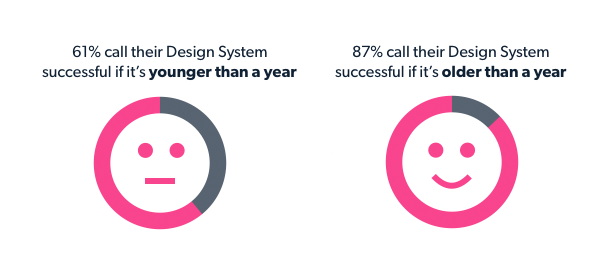
After 1 year there is more in your Design System #
There’s more of everything in your Design System after a year. Especially components, UI patterns, Grid Systems and Design Principles. But also Design-System specific documentation: process, coding standards, ‘about our Design System’ and on-boarding.
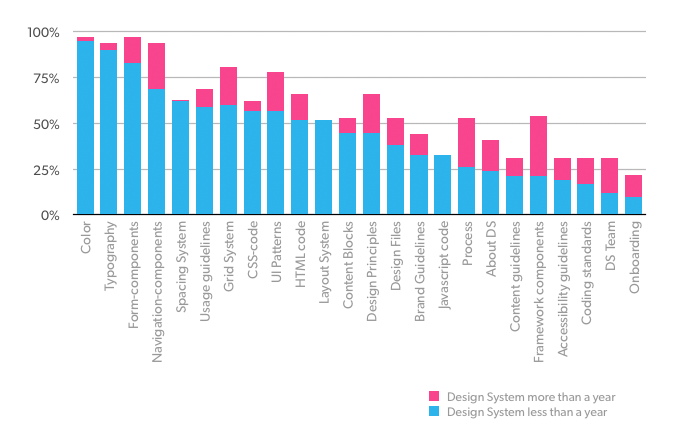
After 1 year your Design System is more mature #
An open door perhaps, but we were very surprised by the huge difference a year can make. Most Design Systems reach stage 3 after a year and a lot are already in Stage 4 or 5!
The Design System maturity index was created by Marcelo Somers and John Gully. It’s a nice metric to see how your Design System is doing.
In the first year, Design Systems are usually in Stage 2 or Stage 3 (a PDF or wiki, or a UI-kit with code-examples). However, all Design Systems older than a year are in Stage 3 or beyond. As a matter of fact, in 23% of the cases these Design Systems are already in the final stage (stage 5), where the Design Systems is governed and part of the organization.
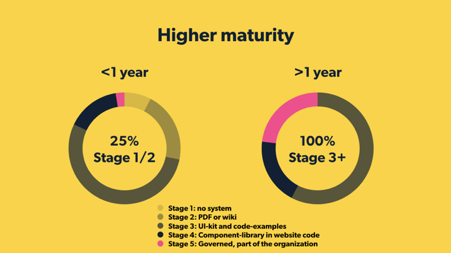
After 1 year your Daily Usage goes up #
Only 44% of participants with a Design System aged less than a year say they use it daily. This percentage goes up to 71% for participants whose Design System is older than a year.
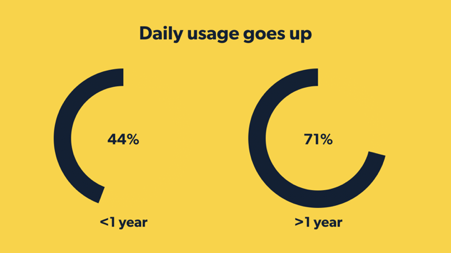
After 1 year more Design System-code is used in production #
One of the most difficult things to get right is making sure your live -site (or application) uses code from the Design System. We see this is especially the case for those organizations whose Design System is less than a year old.
Only 3 out of 10 can say that half of their production-code is coming from their Design System when their Design System is younger than a year. This grows to almost 7 out of 10 participants whose Design System is more than a year!
Even more impressively, almost a third of participants whose Design System age is 1+ year can say 75% of their production code is from their Design System!
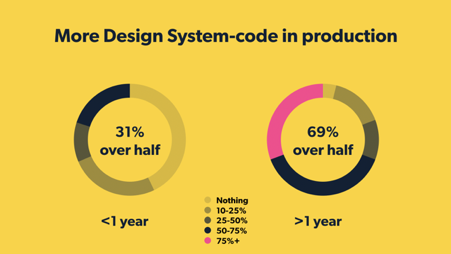
There’s always work to do #
So that’s the positive news 🤣 But a Design System is never finished. This also means you’ll keep running into problems with your Design System process, even after a year.
Participants with a Design System less than a year do have different struggles. After one year, the amount of people having problems with adoption drops from half to almost a third. Another big drop is in funding: from 16% of participants with a Design System less than a year to 6% for those who have a Design System longer than a year.
Problems with adoption drop if a Design System is older than a year
Interestingly, both maintenance and staffing go up after a year (37% to 45% and 33% to 48%, respectively). This makes sense. More content in your Design System means more maintenance, which in turn means you need more people.
Even if your Design System is older than a year, you’ll experience problems. But they are different problems
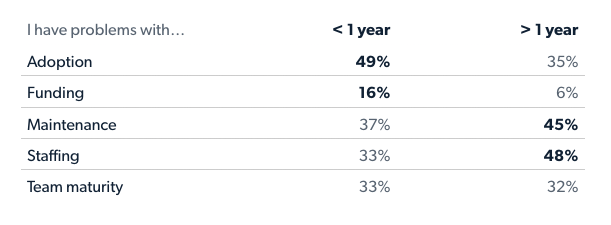

What happens when your Design System is a success? #
Are you doubting whether you want to go down the road of setting up a Design System? We asked our participants if they thought their Design System was a success and why.
Based on quotes from our survey-participants, we can say it’s worth the investment:
“We have a lot of products […] in different countries. [The] Design System is a big step for us to start to keep consistency across all the products and make UX Design transparent across UX teams. There is still a lot of work to do including internal training […]”
“Already saves time and we have more and good discussions about design solutions and ux with all disciplines involved.”
“People don’t ignore it, we’ve got covering from management, people are happy with it. And it’s used by our central platform which covers more than 35 countries ”
“As the adoption rate increases, more developers are inclined to use it from the start.[Developers] are happy that they no longer have to do the tedious work anymore. ”
“ I use it everyday to build my designs while efficiently maintain branding, consistency and accessibility. ”
So good luck with your journey of setting up a Design System! If you have any questions, just contact me (or pm me in the Design Systems slack ), or read the report!
Previously published on Medium: Surviving your 1st year with a design system